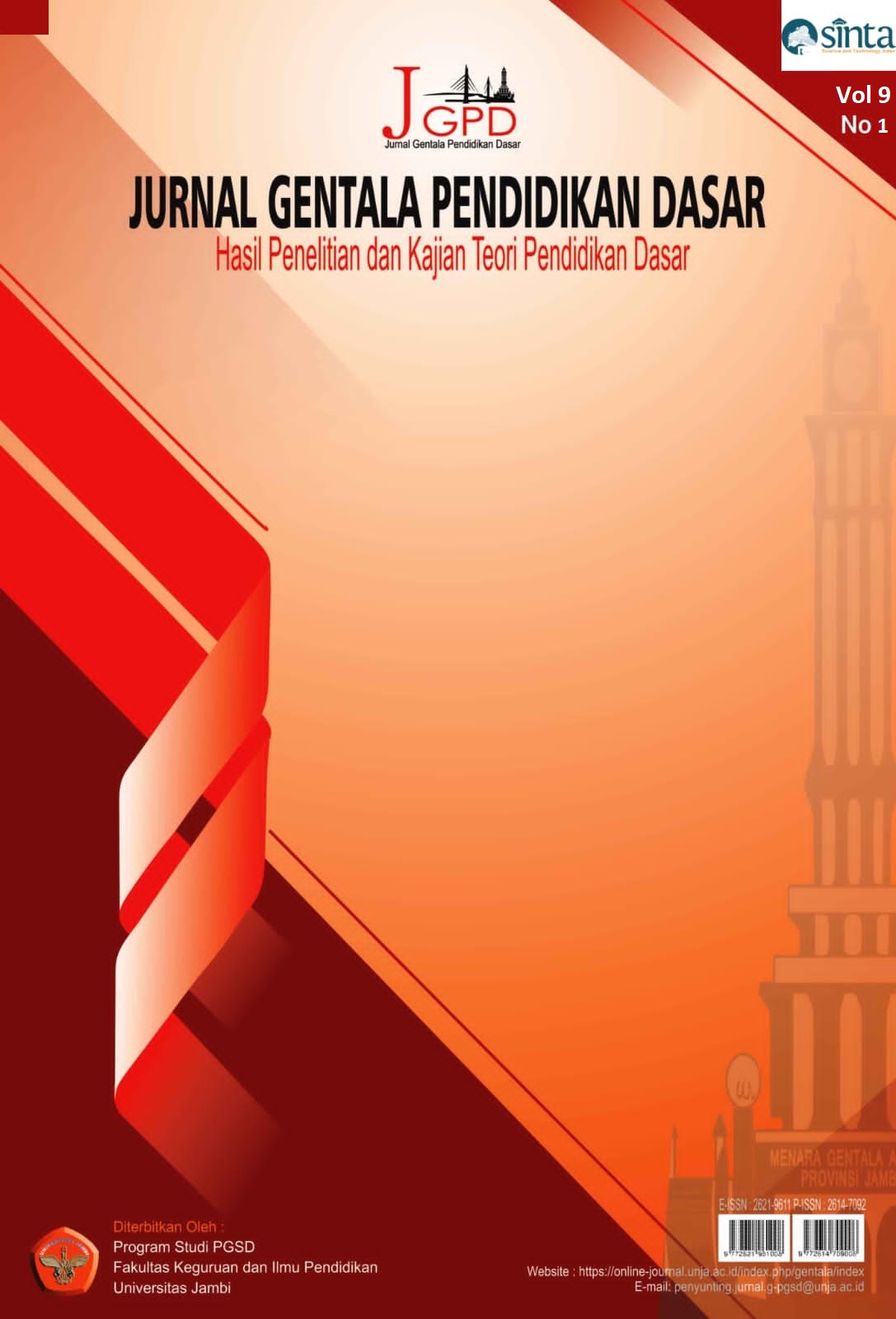Pengembangan Instrumen Motivasi Belajar Siswa: Kuesioner
DOI:
https://doi.org/10.22437/gentala.v9i1.34338Keywords:
Motivasi Belajar, Ilmu Pengetahuan Alam, Instrumen, Sekolah DasarAbstract
The research instrument is an important factor in every study because it determines the accuracy of the research results which determines the conclusions. This tool is used to collect data and measure the object of a research variable. This research aims to re-test instruments related to learning motivation in the Natural Science lesson content for class V SDIT BPMAA Pekanbaru City which are valid and reliable which were previously developed by Aminatun, 2019. In the research These indicators of student learning motivation used are: (1) Perseverance in learning, (2) Tenacity in facing difficulties, (3) Interest and sharp attention in learning, (4) Achievement in learning, and (5) Independence in learning. This research involved 25 student respondents who were selected using purposive sampling technique. Data were analyzed using SPSS version 23.00 for Windows. The results of the research show that the obtained rcount moves from 0.614-0.762 and < rtable = 0.396 with a significance level of 5%. So that the statement items of the student learning motivation instrument are declared valid. Then the calculation results show that the reliability of the student learning motivation instrument is 0.601 with a total of N=25 (number of respondents) of 0.60, resulting in a superior and high quality instrument. This instrument is suitable to be used to measure what should be used to measure and evaluate student learning motivation effectively.
Downloads
References
A.M., Sardiman. (2012). Interaksi & Motivasi Belajar Mengajar. Jakarta: Rajagrafindo Persada.
Abdullah, R. (2015). Urgensi Penilaian Hasil Belajar Berbasis Kelas Mata Pelajaran IPS di Madrasah Tsanawiyah. Latanida Journal. Volume 3, No. 2.
Agustini, K. S. A., Gading, I. K., & Tristayani, L. A. (2016). Pengaruh Metode Pembelajaran Eksperimen Terhadap Keterampilan Proses Sains Pada Kelompok B Semester II TK Kartika VII-3. e-Journal Pendidikan Anak Usia Dini Universitas Pendidikan Ganesha. Volume 4, No. 2, hlm.1–10.
Aji, B. S., & Winarno, M. E. (2016). Pengembangan Instrumen Penilaian Pengetahuan Mata Pelajaran Pendidikan Jasmani Olahraga dan Kesehatan (PJOK) Kelas VIII Semester Gasal. Jurnal Pendidikan: Teori, Penelitian, dan Pengembangan. Volume 1, No. 7, hlm.1449–1463.
Azwar, S. (2012). Reliabilitas dan Validitas. Ed. 4. Yogyakarta, Pustaka Pelajar
Berlian, M., Mujtahid, I. M., Vebrianto, R., & Thahir, M. (2020). Multiple intelligences instrument development: Identification system of multiple intelligences tutor. REID (Research and Evaluation in Education), 6(2), 119-129.
C. Bereiter & M. Scardamalia. 2017 “Child as coinvestigator: Helping children gain insight into their own mental processes,” in Learning and motivation in the classroom, Routledge, , hal. 61–82.
C. R. Wibrowski, W. K. Matthews, dan A. Kitsantas, “The role of a skills learning support program on first-generation college students’ self-regulation, motivation, and academic achievement: A longitudinal study,” J. Coll. Student Retent. Res. Theory Pract., vol. 19, no. 3, hal. 317–332, 2017.
E. A. Vincent, Examining the Experiences of Innovative Counselor Educators: A Grounded Theory Approach. North Carolina State University, 2017.
Emory, C. W., & Cooper, D. R. (1991). Business research methods. Richard D Irwin.
Fahruna, Y., & Fahmi, M. (2017). Validitas dan reliabilitas konstruk pengukuran perpustakaan ideal berbasis pemakai dengan pendekatan LIBQUAL. Jurnal Ekonomi Bisnis Dan Kewirausahaan, 6(2), 161. https://doi.org/10.26418/jebik.v6i2.22989
Galishnikova. EM 2014. Motivasi belajar bahasa: Sekilas tentang program tambahan. Procedia-Ilmu Sosial dan Perilaku. 152. 1137-1142.
Hancock, D. (2004). Cooperative learning and peer orientation effects on motivation and achievement. Journal of Educational Research, 97(3), 159-166. https://doi.org/10.3200/JOER.97.3.159-168
Hardiani, I. N. 2017. Pengembangan Pengembangan Instrumen Penilaian Sikap SosialPembelajaran IPS Kelas IV SD. Jurnal Mitra Pendidikan. Volume1, No. 6, hlm.2550–0481.
Krismony, N. P. A., Parmiti, D. P., & Japa, I. G. N. (2020). Pengembangan instrumen penilaian untuk mengukur motivasi belajar siswa SD. Jurnal Ilmiah Pendidikan Profesi Guru, 3(2), 249-257.
M. Huda, N. Sabani, M. Shahrill, K. A. Jasmi, B. Basiron, dan M. I. Mustari, “Empowering Learning Culture as Student Identity Construction in Higher Education,” in Student Culture and Identity in Higher Education, IGI Global, 2017, hal. 160–179
Mónus, F. (2020). Environmental perceptions and pro-environmental behavior–comparing different measuring approaches. Environmental Education Research, 0(0), 1–25. https://doi.org/10.1080/13504622.2020.1842332
Mudanta, K. A., Astawan, I. G., & Jayanta, I. N. L. (2020). Instrumen penilaian motivasi belajar dan hasil belajar IPA siswa Kelas V Sekolah Dasar. Mimbar Ilmu, 25(2), 262-270.
Norazaini. (2017). Peningkatan Hasil Belajar IPA Menggunakan Media Lingkungan Alam Pada Siswa Kelas III. Jurnal Pendidikan Guru Sekolah Dasar. 7(6), 716–722.
Nunnally, J. (1978). The study of change in evaluation research: Principal concerning measurement, experimental design and analysis. Sage Publication
Pintrich, P. R., Smith, D. A. F., Garcia, T. & McKeachie. (1991). A manual for the use of the motivated strategies for learning questionnaire. National Center for Research to improve Postsecondary Teaching and Learning, Ann Arbor, MI. https://doi.org/10.1037/t09161-0
Rakhmadtullah. R. Zulela. MS. & Sumantri. MS (2019). Multimedia interaktif berbasis komputer: kajian efektivitas pembelajaran tematik integratif di sekolah dasar. Jurnal Fisika: Seri Konferensi. 1175(1). 12028.
Sastradika, D., Iskandar, I., Syefrinando, B., & Shulman, F. (2021). Development of animation-based learning media to increase student’s motivation in learning physics. In Journal of Physics: Conference Series (Vol. 1869, No. 1, p. 012180). IOP Publishing.
Setyawati, R. D., Happy, N., & Murtianto, Y. H. (2017). Instrumen angket self-esteem mahasiswa ditinjau dari validitas dan reliabitas. Jurnal Phenomenon, 7(2), 174–186.
Straub, D., & Gefen, D. (2004). Validation guidelines for IS positivist research. Communications of the Association for Information Systems, 13 (March). https:// doi.org/10.17705/1cais.01324
Sugiyono. (2015). Metode Penelitian Pendidikan Pendekatan Kuantitatif, Kualitatif, dan R&D. Bandung: Alfabeta.
Tran, V. D. (2019). Does Cooperative Learning Increase Students' Motivation in Learning? International Journal of Higher Education, 8(5), 12-20.
Tuan H, Chin C and Shieh S, (2005), The development of a questionnaire to measure students' motivation towards science learning Int J Sci Educ 27 639–654.
Yusup, F. (2018). Uji validitas dan reliabilitas instrumen penelitian kuantitatif. Jurnal Tarbiyah: Jurnal Ilmiah Kependidikan, 7 (1), 17–23. https://doi.org/10.18592/tarbiyah.v7i1.2100
Downloads
Published
How to Cite
Issue
Section
License
Copyright (c) 2024 Suhudi, Radeswandri, Herlinda, Rian Vebrianto

This work is licensed under a Creative Commons Attribution-NonCommercial-ShareAlike 4.0 International License.













